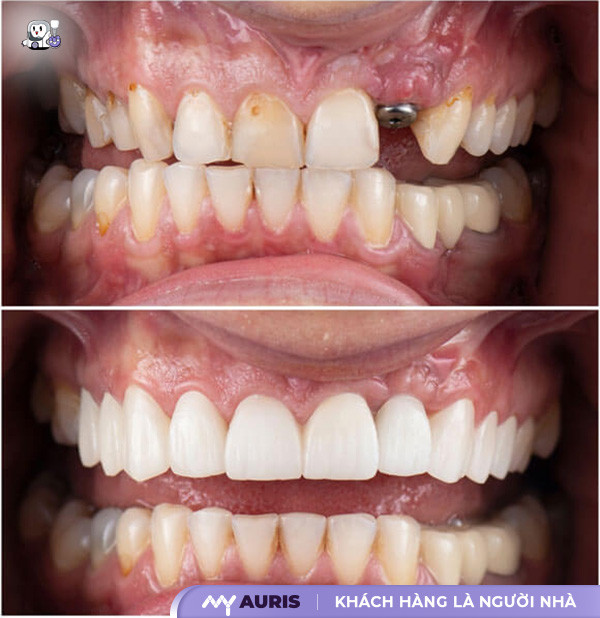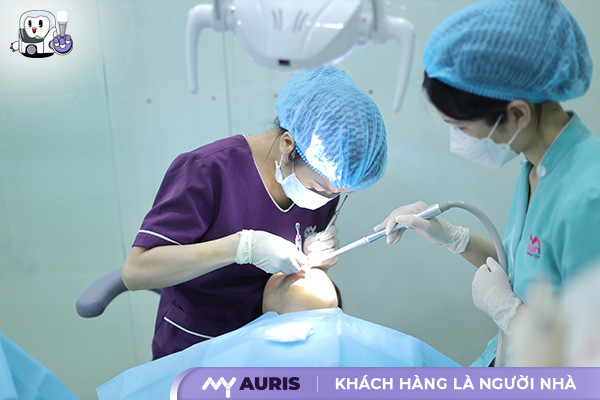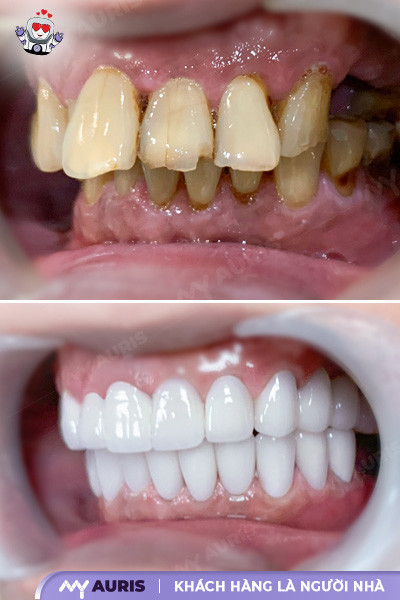Tooth loss severely impacts oral health, chewing function, and facial aesthetics. Dental implant placement is an effective and long-lasting solution for restoring missing teeth, helping you regain a confident smile and optimal oral health. However, the question arises: how long after tooth extraction should an implant be placed? The timing of implant placement directly affects the success of the treatment, making it crucial to understand this issue thoroughly. This article by My Auris will provide you with detailed information, helping you make informed decisions and plan effective dental treatment.
How Long After Tooth Extraction Should You Get an Implant?
The decision on when to place an implant depends on many factors, including oral health, jawbone condition, the type of tooth to be restored, and the patient’s preferences. Below are the common stages:
Immediate Implant Placement After Tooth Extraction: This method is applied when jawbone conditions are ideal. Advantages include saving time and reducing the number of surgeries. However, disadvantages include a higher risk of infection and the need for advanced surgical techniques. The waiting time is shortened but requires high bone quality.
Early Implant Placement (1-2 Months After Tooth Extraction): This is considered the ideal stage for many cases. During this time, gum tissue has stabilized, allowing for a more accurate assessment of bone quality. Initial healing has occurred, minimizing the risk of infection.
Delayed Implant Placement (3-4 Months After Tooth Extraction): This method is suitable for cases where teeth were extracted due to inflammation or when the jawbone requires complete healing time. The alveolar bone has time for natural healing, ensuring the necessary stability for implant placement.
Late Implant Placement (After 4-12 Months): Applied to cases of long-term tooth loss, where bone resorption may have occurred. In this scenario, bone grafting may be necessary to ensure sufficient bone volume to support the implant post. The overall treatment time will be longer.

Things to Consider Before Deciding on Dental Implant Placement
Comprehensive Assessment of Oral and General Health
The first and most important step is a comprehensive assessment of your oral and general health. This includes:
Comprehensive dental examination: The dentist will examine your mouth, assess the condition of your jawbone, gum tissue, and other oral diseases such as periodontitis. Panoramic X-rays and/or Cone Beam CT scans are necessary to accurately evaluate the jawbone structure, helping to determine the feasibility of implant placement and create an appropriate treatment plan.
General health assessment: Certain medical conditions such as diabetes, high blood pressure, or being on immunosuppressant medication can affect the osseointegration process of the implant and increase the risk of complications. The dentist will need your full medical history to assess risks and plan appropriate treatment.
Discussion about the treatment plan: After a comprehensive assessment, the dentist will discuss the detailed treatment plan with you, including the suitable implant type, treatment duration, costs, and potential risks. Ask questions and clarify any concerns you have with the dentist to ensure you fully understand the dental implant procedure and what you need to prepare.

“Regretting Dental Implants”: When to Be Cautious?
While dental implant placement is an effective tooth restoration solution, it is not suitable for everyone. Some cases require careful consideration before deciding:
Poor jawbone condition: If the jawbone has severe resorption or poor quality, implant placement will face many difficulties and may require additional bone grafting procedures. Bone grafting is a complex procedure, extending treatment time and increasing costs.
Serious health issues: Uncontrolled chronic conditions such as diabetes, cardiovascular disease, or being on immunosuppressant medication can affect the healing process and increase the risk of infection.
Smoking habits: Smoking reduces bone integration capability and increases the risk of inflammation, affecting the success of implant placement.
Poor oral hygiene: If you do not maintain good oral hygiene, the risk of peri-implantitis will increase, leading to implant loss.
Unrealistic expectations: Dental implant placement is not a miracle. The final outcome depends on many factors, including jawbone condition, the dentist’s technique, and the patient’s adherence to oral hygiene instructions.
Disadvantages of Dental Implant Placement
Although offering many benefits, dental implant placement also has some disadvantages to consider:
High cost: Compared to other tooth restoration methods such as removable dentures, the cost of dental implant placement is significantly higher. Factors affecting the cost of dental implants include the type of implant post, the number of implants needed, and additional procedures such as bone grafting.
Long treatment time: The implant placement procedure can last several months, even up to a year, depending on the jawbone condition and treatment plan. The waiting period for implant osseointegration is necessary to ensure the stability and longevity of the implant.
Requires good health: Dental implant placement requires good oral and general health. Individuals with chronic medical conditions need to be thoroughly evaluated before making a decision.
Risk of complications: Although rare, there is still a risk of complications such as infection, implant failure, or nerve damage. However, this risk can be minimized by choosing a skilled dentist and strictly following post-operative care instructions.

Detailed “Implant Placement” Procedure from Preparation to Completion
To ensure effectiveness and safety, you need to understand each step in the dental implant placement procedure, helping you feel more confident in your treatment decision:
Stage 1: Examination, CT Scan, and Treatment Planning
The first step in the dental implant procedure is a comprehensive examination and assessment of your oral health. The dentist will examine the condition of your teeth, gums, jawbone, and evaluate your overall health. This is a crucial step to determine if you are eligible for implant placement and to create the most suitable treatment plan.
Cone Beam CT scan is a modern technology that allows the dentist to obtain detailed 3D images of the jawbone, accurately determining the position, size, and quality of the bone to plan precise and optimal implant placement.
After the assessment, the dentist will discuss with you the methods for restoring missing teeth, including the advantages and disadvantages of dental implants compared to other methods such as removable dentures, helping you make an informed treatment decision. The dentist will explain in detail the dental implant procedure, waiting time, dental implant costs, and factors affecting the cost to give you a comprehensive overview.
Stage 2: Implant Post Placement Surgery
Once the treatment plan is established, the next step is implant post placement surgery. This is a specialized dental procedure that requires an experienced and highly skilled dentist. Before surgery, you will receive local anesthesia to ensure a pain-free experience throughout the process. The dentist will create a small hole in the jawbone and place the implant post in the precisely determined position. This process is usually quick and minimally invasive, helping to reduce recovery time. The type of implant post used will also be selected to suit your jawbone condition and needs. After surgery, you will be instructed on wound care, pain medication, and antibiotics if necessary.
Stage 3: Waiting for Osseointegration
After the implant post is placed, a period of time is needed for the implant to integrate with the jawbone. This process is called osseointegration and typically lasts from 3 to 6 months, depending on your bone quality and overall health.
Stage 4: Placing the Porcelain Crown on the Implant
Once the implant post has fully integrated into the jawbone, the dentist will take an X-ray to ensure that the osseointegration process is complete. Afterward, you will have a porcelain crown placed on the implant post. The porcelain crown is custom-made for each case, ensuring optimal aesthetics and chewing function. This process usually takes about 2-3 weeks, including impression taking, design, and fabrication of the porcelain crown. After the porcelain crown is placed, you need to visit the dental clinic for regular check-ups and proper oral care to maintain long-lasting treatment results.
FAQs
How Much Does Molar Extraction Cost?
The cost of molar extraction can vary depending on several factors, such as the reputation of the dental clinic, the extraction technology used, the number of teeth to be treated, and especially the complexity of each clinical case. This explains why the price of molar extraction is not fixed but will have a corresponding fluctuating price.
| Tooth Condition | Standard Extraction | Extraction with Piezotome Machine |
| Upper or lower molar | 500,000 – 1,000,000 VNĐ | 800,000 – 3,000,000 VNĐ |
| Decayed molar | 600,000 – 1,200,000 VNĐ | 800,000 – 3,000,000 VNĐ |
| Tooth Filling | 500,000 VNĐ | – |
For routine tooth extractions or simple root extractions, the cost is usually around 500,000 VNĐ per tooth. This is a simple, minimally invasive extraction technique that does not significantly affect the gums or jawbone, and does not require much supporting equipment.
However, for molar extractions with multiple roots, impacted wisdom teeth, or wisdom teeth with complex eruption patterns, the price can be up to 1,500,000 – 2,500,000 VNĐ per tooth. These cases require high surgical skill from the dentist and support from advanced dental equipment, especially modern technology like the Piezotome extraction machine, which helps reduce pain and shorten healing time.

Comparing the Cost of Molar Extraction vs. Dental Implant Placement
Molar extraction only addresses the issue of damaged teeth but does not restore chewing function or aesthetics. Dental implant placement is a more comprehensive solution that restores both of these factors. Therefore, the cost of implant placement is often significantly higher than merely tooth extraction.
The cost of implant placement depends on several factors:
- Type of implant post: Implant posts are made from different materials, with varying quality and costs.
- Number of implants needed: Placing multiple implants will be more expensive.
- Need for bone grafting: If the jawbone is resorbed or not thick enough, bone grafting may be necessary, increasing the cost.
- Type of porcelain crown: Porcelain crowns also come in various types with different prices.
- Examination and consultation fees: Costs for examination, X-rays, CT scans, and treatment planning.
The total cost of placing one implant can range from tens of millions to over a hundred million VND, depending on the factors mentioned above. It is best to visit reputable clinics for consultation and specific quotes. Comparing costs from multiple places will help you make the optimal choice. Prioritize the quality of treatment and safety rather than just focusing on low prices. A quality implant will have a long lifespan and provide long-lasting effectiveness.





